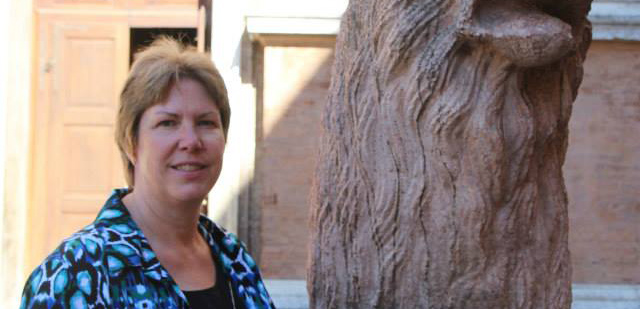Dreams do come true and that is what the trip to Italy was, a vision that became reality! This trip wouldn’t have been possible without the support and allegiance from the Dean of the School of Education and Human Services, Dr. Robert Barnett. His belief in the Early Childhood Development Center made it all possible. Having the opportunity to visit Florence, Reggio Emilia and then Venice provided vastly different experiences. The history and striking architect of Italy certainly sets it apart from the United States, but the people are very similar although it seems they have different agendas.
We Americans move way too fast, take on too many projects and consider ourselves the masters of multitasking, but at what cost? As an educator I’m trained to observe and look for the strengths of the children and the adults I work with. This takes time, patience and perseverance. The Italians seem to have this lifestyle embedded from the markets I visited, to the elders that sit in the park talking or playing dominoes. and the time taken in the afternoon to reflect, refresh or rejoice by having their businesses closed. I haven’t quite figured out how having dinner at 8 pm actually works, and how the schools manage parent meetings at 9 pm at night? There are definitely practices in Italy that I would have a very hard time adapting.
The conference at the Loris Malaguzzi International Centre of Reggio Emilia, Italy was truly enlightening but most of all reaffirming that the direction the ECDC is headed is right on course with our Reggio inspired approach in the heart of Flint, MI. It is refreshing to know all the hard work we have done thus far in our journey at the ECDC is indeed considered Reggio inspired. I desperately tried to absorb every word, image and experience that was offered by those amazing Italian educators. My mind sorted out ways to incorporate concepts with the children, families but most of all staff who have the challenge to utilize a developmentally appropriate, stimulating environment to be that ever supportive third teacher. I captured amazing ideas that the teachers could use from the ateliers that were set up, “A Ray of Light” and “Digital Technologies”. Many basic and quite simple concepts that could be put to use right away with the materials we have readily available at the center.
An important message that will stay with me for as long as I’m a Director of a Nationally Accredited, Reggio Inspired, Lab School is that the staff responsible for ensuring the quality education that is required must first be passionate about the field, dedicated to collaborating with others, but most of all be open-minded and willing to change. These points reassured me that it was time to make sure that all the full-time ECDC staff were indeed committed to the Reggio philosophy and that they are invested to make a change in themselves to improve our practices as a unified team. Just a few days after we returned from Reggio, we had a staff meeting as I was able to outline the direction that we would be headed as fall approaches.
First each classroom teacher needs to think about the topic(s) that they are interested in and intend to present to their class in a variety of ways to see where the children take the learning process. They are encouraged to map out the variety of paths that the topic could take them, so when the interest slows down they have a means of rekindling the fire. Next each teacher needs to think about a research question or two that they want to investigate about the children’s learning. This question will keep the teacher focused and provide a means to make the children’s learning visible. In addition documentation of the process will be required in a form of a Learning Story which should include the research question, pictures, children’s dialogue and how the learning taking place meets the state standards. This learning story will be expected every other week and presented to the families by email and publically displayed for accountability purposes. Already set up for training in August is a colleague from Lansing Community College who will help the staff with developing research questions and another colleague from Building Blocks, who is a master at developing learning stories, will help mainstream the process by showing how the documentation used to make the story can also be used as an observation for an individual child.
Meanwhile collaboration is key so my goal is to establish appropriate meeting times so that each classroom can meet with their entire team about every three weeks. The Head Teacher and the Assistant also need a block of time to meet weekly in order to generate projection plans and to keep the Cycle of Inquiry going. Meeting as a full-time staff is also crucial to provide support, build relationships, and to share the exciting events happening in each classroom.
The Friday of Spring Break 2015 will host the second annual iMagine a Difference at UM-Flint ECDC conference where each classroom will host a breakout session regarding the research topic of their classroom. A compilation of documentation will be expected in any format the teacher desires to showcase the learning that took place throughout the year. This format will showcase the ECDC in the community but also serve as a platform for the ECDC Teachers to be acknowledged for the work of their classroom and the education of the students.
As the days fly by since my return, I’m often reminded about something I saw or heard while in Italy and know that my experience there will forever change my course as an educator and administrator.

